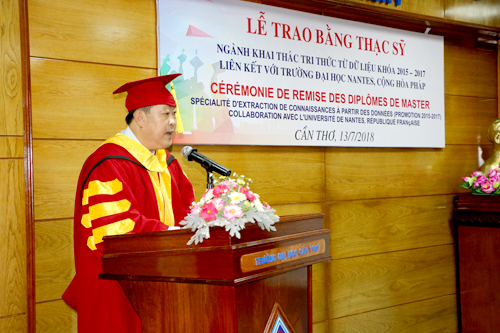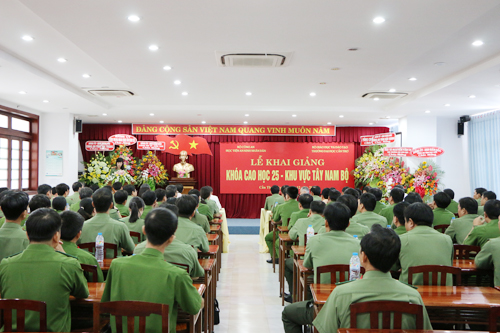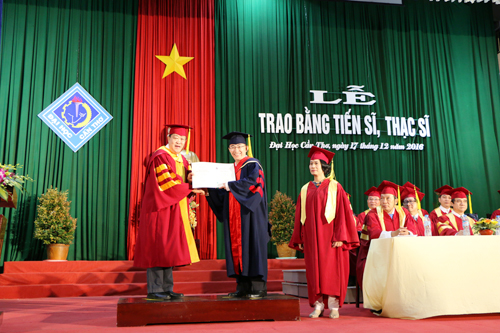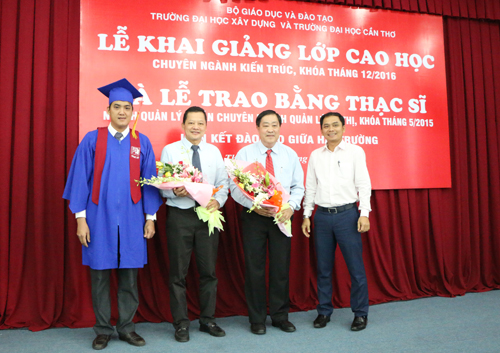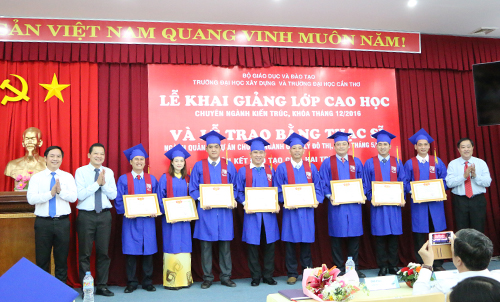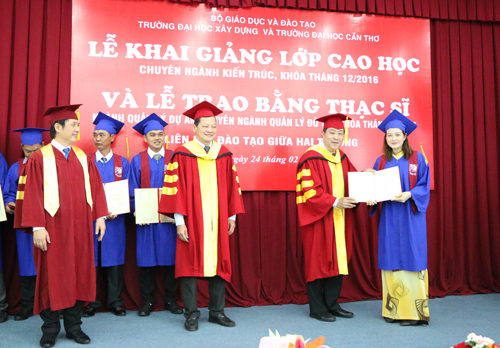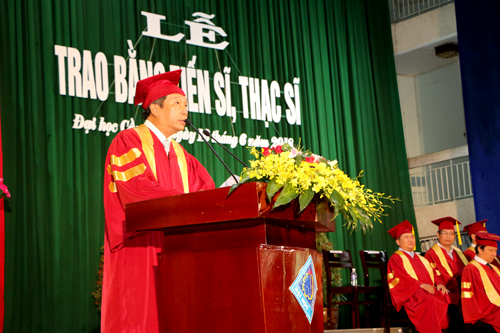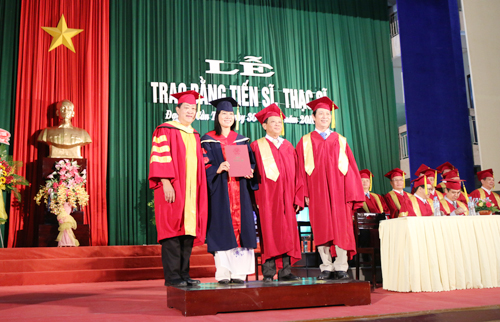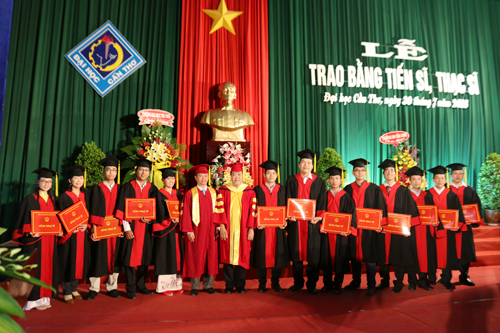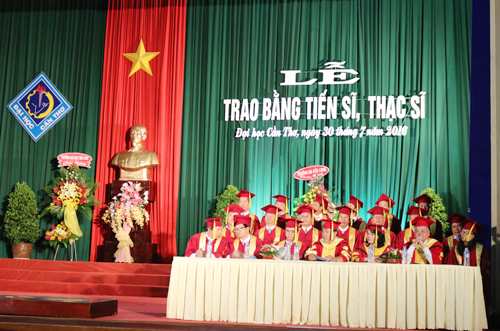
Tên đề tài: “Nghiên cứu bệnh thán thư trên thanh long và biện pháp quản lý tổng hợp”.
Tác giả: Đặng Thị Kim Uyên, Khóa: 2015
Chuyên ngành: Bảo vệ thực vật; Mã số: 62620110. Nhóm ngành: Nông, lâm nghiệp và thuỷ sản.
Người hướng dẫn chính: PGS.TS. Trần Vũ Phến - Trường Đại học Cần Thơ
Người hướng dẫn phụ: TS. Nguyễn Văn Hòa - Viện Cây ăn quả miền Nam
- Tóm tắt nội dung luận án: Luận án với tiêu đề “Nghiên cứu bệnh thán thư trên cây thanh long và biện pháp quản lý tổng hợp” được thực hiện từ tháng 02 năm 2015 đến tháng 12 năm 2019, tại 3 tỉnh Tiền Giang, Long An và Bình Thuận với các thí nghiệm được thực hiện tại phòng thí nghiệm và ngoài đồng nhằm để xác định tác nhân gây bệnh, điều kiện lưu tồn phát sinh phát triển của bệnh và nghiên cứu một số biện pháp phòng trừ có hiệu quả đối với bệnh thán thư (Colletotrichum spp.) trên thanh long. Nội dung luận án bao gồm: (i) Thu thập và định danh các loài từ chi Colletotrichum gây bệnh thán thư trên thanh long bằng đặc điểm hình thái học và kỹ thuật sinh học phân tử. (ii) Nghiên cứu một số điều kiện phát sinh và phát triển của bệnh thán thư trên thanh long. (iii) Đánh giá một số biện pháp phòng trừ tổng hợp. Kết quả đã đạt được: (1) Đã Thu thập và phân lập được 44 chủng nấm gây bệnh thán thư trên thanh long, qua phân loại hình thái kết hợp kỹ thuật sinh học phân tử, giải trình tự gen, so sánh và phân tích trình tự DNA trên vùng ITS-rDNA đã khẳng định được các chủng thuộc loài Colletotrichum gloeosporioides và Colletotrichum truncatum. (2) Loài nấm C. gloeosporioides và C. truncatum đều gây bệnh trên giống thanh long ruột trắng Chợ Gạo, giống ruột trắng Bình Thuận, giống ruột đỏ và giống tím hồng, trong đó loài C. truncatum gây hại nặng nhất là trên giống thanh long ruột đỏ. Nhằm hiểu rõ nguồn gốc mầm bệnh phát sinh của bệnh thán thư gây hại thanh long, nghiên cứu về sự hiện diện nấm Colletotrichum trong nước mưa, nước mương, rãnh, tàn dư thực vật và mẫu đất ở độ sâu (0 - 10 cm) trong vườn thanh long được tiến hành. Kết quả thu thập được 8 chủng nấm Colletotrichum từ các mẫu nước mưa, nước mương, mô chết-tàn dư thực vật và đất trong vườn thanh long tại Tiền Giang, Long An và Bình Thuận và các chủng nấm này đều gây bệnh thán thư trên cành thanh long qua quy trình Koch. Bệnh thán thư phát sinh và gây hại nặng nhất vào tháng có lượng mưa và ẩm độ cao trong năm, bắt đầu xuất hiện từ tháng 6 dương lịch. Đỉnh điểm gây hại nặng vào tháng 9 đến tháng 10 năm 2018, thời điểm này trùng vào mùa mưa tại Đồng Bằng Sông Cửu Long. (3) Hoạt chất hóa, sinh học như Azoxystrobin + Difenoconazole, Propiconazole + Difenoconazole, Difenoconazole và Polyoxin complex có hiệu quả ức chế tản nấm Colletotrichum gloeosporioides và Colletotrichum truncatum phát triển với hiệu lực từ 72% đến 93,75%. Dịch trích cây móng tay ở nồng độ 2% có hiệu lực ức chế nấm gây bệnh thán thư trên thanh long từ 56% đến 93,7%. Tuyển chọn được các dòng vi khuẩn Bacillus (TB–TL–BS 4; DN–X–BS 4; VL–N–BS 1; VL–N–BS 2; VT–N–BS 1; VT–N–BS 2; VK3; BS) có hiệu suất đối kháng từ 62% đến 68% và chủng xạ khuẩn (TG8, TG12, BT3, TG17, TG11 và BT1) có hiệu suất đối kháng từ 50% đến 71,3% đối với tác nhân gây bệnh thán thư trên thanh long ở điều kiện phòng thí nghiệm. Ở điều kiện ngoài đồng áp lực bệnh cao (tỷ lệ bệnh trên 20%) dùng hoạt chất Difenoconazole, Azoxystrobin + Difenoconazole, Propiconazole + Difenoconazole, dịch trích cây móng tay cho hiệu quả cao, ức chế sự phát triển của đường kính vết bệnh và tỷ lệ bệnh thán thư. Ngoài ra, đối với áp lực bệnh thấp (tỷ lệ bệnh dưới 20%) trong vườn dùng hoạt chất sinh học Streptomyces lydicus và Polyoxin complex, xạ khuẩn (TG17) và vi khuẩn (VL–N–BS 2) có hiệu quả phòng ngừa được bệnh. Trên mô hình diện hẹp, áp dụng giải pháp quản lý tổng hợp như cắt tỉa loại bỏ mầm bệnh ra khỏi vườn và kết hợp phun các hoạt chất Propiconazole + Difenoconazole, dịch trích cây móng tay, Streptomyces lydicus, Polyoxin complex, xạ khuẩn (TG17) và vi khuẩn (VL–N–BS 2) giảm được áp lực bệnh, giảm được số lần phun thuốc và tăng lợi nhuận so với tập quán nông dân.
- Những kết quả mới của luận án:
Tại Việt Nam xác định được loài Colletotrichum gloeosporioides và Colletotrichum truncatum gây bệnh thán thư trên thanh long được đánh giá là phát hiện được loài tác nhân gây bệnh đầu tiên trên cây thanh long và Nấm Colletotrichum lưu tồn trong nước mưa, nước mương, tàn dư thực vật và trong đất và một số yếu tố ẩm độ và lượng mưa ảnh hưởng đến sự phát sinh, phát triển của bệnh trong năm. Ngoài ra còn xác định được một số giải pháp hiệu quả trong phòng trừ bệnh thán thư (dịch trích thảo mộc, vi sinh vật, nông dược) giúp giảm được áp lực bệnh, giảm được số lần phun thuốc và tăng lợi nhuận so với tập quán nông dân trên mô hình diện hẹp và đây cũng là hợp phần kỹ thuật cho bước đầu xây dựng quy trình tổng hợp như áp dụng giải pháp quản lý tổng hợp như cắt tỉa loại bỏ mầm bệnh ra khỏi vườn và kết hợp phun các hoạt chất Propiconazole + Difenoconazole, dịch trích móng tay, Streptomyces lydicus, Polyoxin complex, xạ khuẩn (TG17) và vi khuẩn (VL–N–BS 2) giảm được áp lực bệnh, giảm được số lần phun thuốc và tăng lợi nhuận so với tập quán nông dân trên mô hình diện hẹp
Luận án còn cung cấp giữ liệu khoa học về bệnh thán thư thuộc chi nấm Colletotrichum một cách có hệ thống, khẳng định được nấm Colletotrichum gloeosporioides và C. truncatum là tác nhân gây bệnh (giải trình tự vùng ITS), điều kiện xâm nhiễm, khả năng lưu tồn, phát sinh và phát triển của bệnh. Ngoài ra còn tuyển chọn được dòng vi sinh vật, dịch trích thảo mộc, nông dược là cơ sở bước đầu cho việc phòng trừ bệnh thán thư.
Kết quả nghiên cứu cung cấp các số liệu khoa học về đặc điểm hình thái, sinh học của loài nấm gây bệnh thán thư trên thanh long, việc nhận diện triệu chứng bệnh thán thư chính xác sẽ giúp cho việc phòng trừ bệnh chủ động và hiệu quả hơn; xác định được quy trình ứng dụng kết hợp các biện pháp hiệu quả trong kiểm soát bệnh, góp phần giảm thiểu tổn thất do bệnh, cải thiện năng suất và kéo dài chu kỳ kinh tế cho cây thanh long. Kết quả luận án còn là nguồn tài liệu cho các nhà khoa học, cán bộ kỹ thuật, sinh viên tại các Viện, Trường tham khảo trong việc định hướng nghiên cứu lĩnh vực này, xây dựng tài liệu giảng dạy, tài liệu tập huấn kỹ thuật cho cán bộ khuyến nông và nông dân.
- Các ứng dụng/khả năng ứng dụng trong thực tiễn, các vấn đề cần tiếp tục nghiên cứu:
Nông dân trồng thanh long áp dụng giải pháp quản lý tổng đánh giá rằng trồng thanh long theo giải pháp quản lý tổng hợp giảm lượng thuốc hóa học sử dụng trong vườn thanh long, tăng thuốc trừ bệnh theo hướng sinh học. tăng chất lượng và độ an toàn của trái thanh long. Điều đó đã giúp ích cho nông dân trong việc bán thanh long và cải thiện giá thanh long. Mặt khác, trồng thanh long theo giải pháp quản lý tổng hợp cải thiện được môi trường sống, môi trường sản xuất và sức khỏe của người dân so với giải pháp tập quán của nông dân. Để quản lý bệnh than thư trên thanh một cách hiệu quả cần chú ý kiểm soát sự lưu tồn của nấm Colletotrichum spp. từ các nguồn khác nhau góp phần ngăn ngừa sự phát sinh và phát triển của bệnh thán thư trên đồng ruộng. Ngoài ra cần xác định thành phần kháng nấm mạnh nhất của cây móng tay và chế phẩm sinh học xạ khuẩn, Bacillus để đa dạng hóa sản phẩm dung trên cây thanh long./.
Thesis title: “Study on anthracnose disease on dragon fruit and its integrated management measures.”
Speciality: Plant Protection
Speciality ID: 62 62 01 12
PhD student: Dang Thi Kim Uyen.
Principal supervisor: Assoc. Prof. Dr. Tran Vu Phen.
Co-supervisor: Dr. Nguyen Van Hoa
Academic institute: CanTho University.
- Thesis summary
The thesis titled "Study on anthracnose disease on dragon fruit and its integrated management measures" had been carried out from February 2015 to December 2019 at three provinces of Tien Giang, Long An and Binh Thuan. The experiments had been carried out at both in the laboratory and under field conditions to identify the causal agent, suitable conditions for the disease development and study on some effective control measures against anthracnose (Colletotrichum spp.) on dragon fruit (DF). The contents of the thesis include: (i) Collection and identification of species from the genus Colletotrichum causing anthracnose disease on DF by morphological characteristics and molecular biological techniques. (ii) Research on some conditions for the arising and development of anthracnose on DF. (iii) Evaluation of some integrated control measures. The results showed that: (1) Collected and isolated 44 strains of fungi causing anthracnose on DF, through morphological classification combining molecular biological techniques, gene sequencing, comparison and analysis. DNA sequence analysis on the ITS-rDNA region confirmed strains belonging to Colletotrichum gloeosporioides and Colletotrichum truncatum species. (2) The fungus C. gloeosporioides and C. truncatum both cause diseases on Cho Gao white flesh DF variety, Binh Thuan white flesh variety, red flesh and pink purple flesh varieties, in which C. truncatum species caused the heaviest damage, especially on red flesh DF variety. In order to understand the source of the inoculum of the anthracnose disease affecting DF, research on the presence of Colletotrichum fungus in rainfall, ditch, cannel water, plant residues and soil samples at depths (0 - 10 cm) in DF garden was conducted. The results showed that collected 8 strains of Colletotrichum fungus had been collected from samples of rainwater, ditch water, dead tissue-plant residues and soil in DF gardens at Tien Giang, Long An and Binh Thuan and these strains all caused anthracnose disease on DF branches through Koch postulation. Anthracnose disease arose and caused the most damage in the month with high rainfall and humidity of the year, starting from June of the year. The peak of severe damage was from September to October, 2018, which coincided with the rainy season in the Mekongriver delta region in Vietnam. (3) Chemical and biological active ingredients such as Azoxystrobin + Difenoconazole, Propiconazole + Difenoconazole, Difenoconazole and Polyoxin complex were effectively inhibit the growth of the fungus Colletotrichum gloeosporioides and Colletotrichum truncatum with an efficacy from 72% to 93.75%. The Impatiens balsamina extract at a concentration of 2% had an inhibitory effect on the fungus causing anthracnose on DF from 56% to 93.7%. Selection of Bacillus strains (TB–TL–BS 4; DN–X–BS 4; VL–N–BS 1; VL–N–BS 2; VT–N–BS 1; VT–N–BS 2; VK3; BS) had antagonistic efficiency from 62% to 68% and Actinomycete strains (TG8, TG12, BT3, TG17, TG11 and BT1) had antagonistic efficiency from 50% to 71.3% against the agent causing anthracnose disease on DF under laboratory conditions. In field conditions with high disease pressure (disease rate over 20%) using active ingredients Difenoconazole, Azoxystrobin + Difenoconazole, Propiconazole + Difenoconazole, the Impatiens balsamina extract for high efficiency, inhibiting the growth of wound diameter and disease severity of anthracnose. In addition, for low disease pressure (disease rate less than 20%) in the garden, using biologically active ingredients Streptomyces lydicus and Polyoxin complex, actinomycetes (TG17) and bacteria (VL–N–BS 2) were effective in preventing disease. On a small scale model, applied integrated management solutions such as pruning to remove pathogens from the garden and combined spraying with active ingredients Propiconazole + Difenoconazole, the Impatiens balsamina extract, Streptomyces lydicus, Polyoxin complex, actinomycete (TG17)) and bacteria (VL–N–BS 2) reduced disease pressure, reduced the number of sprays and increased profits compared to farmers' practices.
- The novelty of the thesis
(1) Identification of species Colletotrichum gloeosporioides and Colletotrichum truncatum causing anthracnose disease on DF in Southern provinces;
(2) Colletotrichum fungus persists in rain drops, ditch water, plant residues and soil of orchard and the conditions affects on the arision and development of diseases around the year;
(3) Apply integrated management solutions such as pruning to remove pathogens from the orchards and combine spraying of Propiconazole plus Difenoconazole, the Impatiens balsamina extract, Streptomyces lydicus, Polyoxin complex, actinomycetes (TG17) and bacteria (VL–N–BS 2) reduced disease pressure, reduced the number of sprays and increased profits as comparision to farmers' practices on a narrow scale model.
- Application prospect and suggestions for further study
- Application prospect
The research results provide scientific data on the morphological and biological characteristics of the fungus causing anthracnose disease on DF, the accurate diagnosis of anthracnose disease base on its symptoms will help to proactively prevention and disease control more effective; identified an application process that combines effective measures in disease control, contributing to minimizing disease losses, improving yield and prolonging the economic cycle for DF.
- Suggestions for further study
- Pay attention to control the persistence of Colletotrichum spp. from different sources contribute to preventing the occurrence and development of anthracnose in the field.
- Build more integrated management models on a larger scale.
- Identify the most potential antifungal component of the Impatiens balsamina plant.
- Xem chi tiết nội dung luận án
- Xem thông tin đăng tải tại Website Bộ giáo dục và Đào tạo. (Nhập tên NCS vào ô tìm kiếm)





